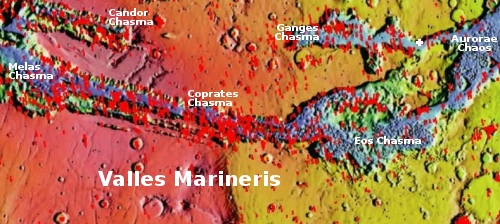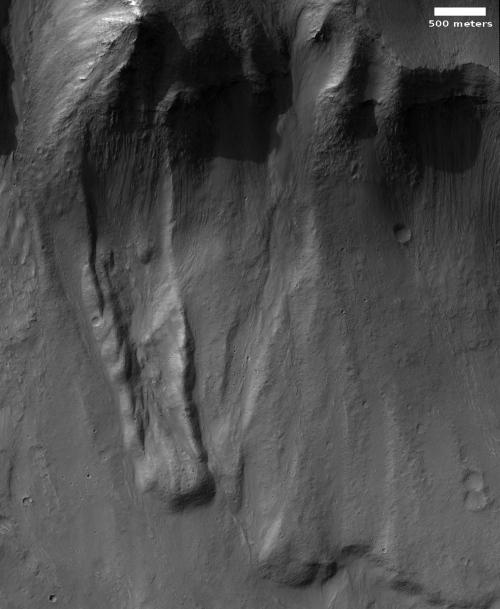A collapsing north wall in Valles Marineris
Cool image time! The photo to the right, rotated, cropped, and reduced to post here, was taken on July 17, 2021 by the high resolution camera on Mars Reconnaissance Orbiter (MRO). It shows what the scientists label as an alluvial fan.
I have also seen them label this kind of avalanche as mass wasting, where the material moves down slope suddenly in a single mass.
The image shows the aftermath of such an event, after a large blob of material broke free from the mountainside and slid almost as a unit downhill to settle more than two miles away on the floor of the canyon. The distance traveled and the blobby nature of the flow both reveal how the lower Martian gravity changes the nature of such events, compared to what you might see on Earth. The flows can travel farther, and can hold together as a unit easier.
The overview map below not only provides the context, but it tells us that such events are remarkably common in this place.

The white cross marks the location of this landslide, in the easternmost point of Ganges Chasma. The red boxes indicate other photos taken by MRO’s high resolution camera. If you go here you can take a gander at each by clicking the arrow button in the top menu and then clicking on each red box.
If you do this, what you will find is that along the north wall of Ganges Chasma, especially in the area where today’s cool image is located, there are many similar mass wasting events. This canyon wall is slowly growing, as its north cliff retreats backwards with each landslide.
The decaying nature of this cliff suggests that the material has some fundamental structural weakness. The blobby nature of the events suggest the possibility of underground layers of ice, even though this is in the dry equatorial regions at 8 degrees south latitude. It could even be that the scientists who are requesting these images are looking for exactly that. To identify such ice layers will require analysis of the full resolution images, which are in a different format and require different software to view, as well as the radar data taken by both MRO and Mars Express.
On Christmas Eve 1968 three Americans became the first humans to visit another world. What they did to celebrate was unexpected and profound, and will be remembered throughout all human history. Genesis: the Story of Apollo 8, Robert Zimmerman's classic history of humanity's first journey to another world, tells that story, and it is now available as both an ebook and an audiobook, both with a foreword by Valerie Anders and a new introduction by Robert Zimmerman.
The print edition can be purchased at Amazon or from any other book seller. If you want an autographed copy the price is $60 for the hardback and $45 for the paperback, plus $8 shipping for each. Go here for purchasing details. The ebook is available everywhere for $5.99 (before discount) at amazon, or direct from my ebook publisher, ebookit. If you buy it from ebookit you don't support the big tech companies and the author gets a bigger cut much sooner.
The audiobook is also available at all these vendors, and is also free with a 30-day trial membership to Audible.
"Not simply about one mission, [Genesis] is also the history of America's quest for the moon... Zimmerman has done a masterful job of tying disparate events together into a solid account of one of America's greatest human triumphs."--San Antonio Express-News
Cool image time! The photo to the right, rotated, cropped, and reduced to post here, was taken on July 17, 2021 by the high resolution camera on Mars Reconnaissance Orbiter (MRO). It shows what the scientists label as an alluvial fan.
I have also seen them label this kind of avalanche as mass wasting, where the material moves down slope suddenly in a single mass.
The image shows the aftermath of such an event, after a large blob of material broke free from the mountainside and slid almost as a unit downhill to settle more than two miles away on the floor of the canyon. The distance traveled and the blobby nature of the flow both reveal how the lower Martian gravity changes the nature of such events, compared to what you might see on Earth. The flows can travel farther, and can hold together as a unit easier.
The overview map below not only provides the context, but it tells us that such events are remarkably common in this place.

The white cross marks the location of this landslide, in the easternmost point of Ganges Chasma. The red boxes indicate other photos taken by MRO’s high resolution camera. If you go here you can take a gander at each by clicking the arrow button in the top menu and then clicking on each red box.
If you do this, what you will find is that along the north wall of Ganges Chasma, especially in the area where today’s cool image is located, there are many similar mass wasting events. This canyon wall is slowly growing, as its north cliff retreats backwards with each landslide.
The decaying nature of this cliff suggests that the material has some fundamental structural weakness. The blobby nature of the events suggest the possibility of underground layers of ice, even though this is in the dry equatorial regions at 8 degrees south latitude. It could even be that the scientists who are requesting these images are looking for exactly that. To identify such ice layers will require analysis of the full resolution images, which are in a different format and require different software to view, as well as the radar data taken by both MRO and Mars Express.
On Christmas Eve 1968 three Americans became the first humans to visit another world. What they did to celebrate was unexpected and profound, and will be remembered throughout all human history. Genesis: the Story of Apollo 8, Robert Zimmerman's classic history of humanity's first journey to another world, tells that story, and it is now available as both an ebook and an audiobook, both with a foreword by Valerie Anders and a new introduction by Robert Zimmerman.
The print edition can be purchased at Amazon or from any other book seller. If you want an autographed copy the price is $60 for the hardback and $45 for the paperback, plus $8 shipping for each. Go here for purchasing details. The ebook is available everywhere for $5.99 (before discount) at amazon, or direct from my ebook publisher, ebookit. If you buy it from ebookit you don't support the big tech companies and the author gets a bigger cut much sooner.
The audiobook is also available at all these vendors, and is also free with a 30-day trial membership to Audible.
"Not simply about one mission, [Genesis] is also the history of America's quest for the moon... Zimmerman has done a masterful job of tying disparate events together into a solid account of one of America's greatest human triumphs."--San Antonio Express-News



It seems to me that if it is from melting ice, seismic activity might not be required. If not, these events happen by Mars quacks.
Reminds me of some large earthly slides, likely Pleistocene, where a chunk of mountainside (probably saturated and possibly seismically induced) collapsed onto the adjacent alluvial apron. The one I’m most familiar with is the Blackhawk Landslide, on the north slopes of the San Bernardino Mountains in California. A LIDAR image would have similar features to this image. By the way, I’d love to hear a “Mars quack”!